मैं हाल ही में एक दशक से अधिक के अंतराल के बाद railwaying मॉडल करने के लिए वापस आ गए. जब से मैं पिछले मॉडलिंग, चीजें काफी बदल गया है, मॉडलिंग सॉफ्टवेयर जो लेआउट ध्यान से अग्रिम में तैयार किया जा करने की अनुमति देता की व्यापक उपलब्धता के साथ - डिजाइन सुनिश्चित अंतरिक्ष में फिट होगा, और आवश्यक ट्रैक उपलब्ध है कि.
ट्रैक के संदर्भ में, सबसे modellers अब सहित कारणों की एक श्रृंखला के लिए Peco सरल ट्रैक की सिफारिश: यह बेहतर चल रहा है माना जाता है, बिंदु त्रिज्या बड़े इंजनों के उच्च गति से चलाने के लिए अधिक उपयुक्त हैं, और वहाँ पर पहले से तैयार ट्रैक टुकड़े का एक व्यापक रेंज उपलब्ध है. सभी ने कहा कि, I still have a large collection of SeTrack so I decided to design my layout to work with this track to avoid the cost of replacing it with newer Streamline.
SeTrack के साथ एक बुनियादी चक्र का निर्माण काफी सरल है, लेकिन अधिक जटिल लेआउट मुश्किल हो सकता है, और इसलिए मैं कुछ मानक ज्यामिति लेआउट मेरी मदद करने के लिए गूगल पर देखने का फैसला किया. हार्नबी एक काफी बुनियादी लेआउट खुद को जो घुमावदार अंक के लिए आंशिक रूप से उपयोगी है प्रदान करते हैं, लेकिन मैं किसी भी अन्य ज्यामिति साइटों है कि सही ज्यामिति के एक व्यापक सेट शामिल खोजने में असमर्थ था. सबसे अच्छा मैं खोज करने में कामयाब हो गया था FreeTrackPlans.com जो एक बहुत ही उपयोगी प्रारंभिक बिंदु था, but sadly includes several examples which don’t actually fit very well together.
नीचे ट्रैक ज्यामिति के एक बड़े सेट मैं AnyRail में तैयार किया गया है 5. AnyRail योजना भी है उपलब्ध. लेकिन मैं जिन मामलों में समस्या एक सीधे टुकड़ा है जो आंशिक रूप से बहुत छोटा है के कारण होता है करने के लिए इन खामियों प्रतिबंधित कर दिया है - मैं वहाँ नीचे कुछ उदाहरण तकनीकी रूप से पूरी तरह से फिट नहीं है कि नोट करना चाहिए. मेरा मानना है कि एक वास्तविक दुनिया मॉडल में इस त्रुटि यह उस बात के अभ्यस्त इतना छोटा है कि, और एक प्रतिरूप तैयार करने वाला आसानी से एक लंबे समय तक सीधे टुकड़ा का उपयोग करने और लंबाई के लिए यह कटौती करके उन्हें सही कर सकता है इसके अलावा कि. इस तरह के बहुत मामूली बेमेल प्रश्न में संयुक्त पर गुलाबी में हाइलाइट किया जाता. ऐसे सभी खामियों AnyRail tolerances के भीतर कर रहे हैं - के रूप में उनके मार्गदर्शन का कहना है: "कभी-कभी आप खेलने का उपयोग करके ट्रैक फिट कर सकते हैं (विगेल कमरा) ट्रैक में. इस धोखाधड़ी पर विचार किया जा सकता है, कभी कभी तुम भी सूचना नहीं है कि आप क्या कर रहे हैं सिर्फ इतना है कि जब वास्तविक ट्रैक बिछाने ".
आप प्रत्येक ज्यामिति के सिरों पर स्तर-क्रॉसिंग का एक बहुत देख सकते हैं - इन प्रदर्शित करने के लिए मौजूद हैं कि सिरों पर ट्रैक की लंबाई में बराबर और SeTrack के लिए सही 67mm समानांतर जुदाई है.
Where shown the grid lines illustrate 50cm squares for scale purposes
नोट करने के लिए एक अंतिम बात हो और OO गेज ट्रैक मानकों के लिए निम्नलिखित विनिर्देशों हैं. नीचे geometries 67mm हार्नबी / SeTrack लिए कर रहे हैं, 50mm Peco / कारगर बनाने के लिए नहीं
4मिमी OO गेज ट्रैक ज्यामिति - हार्नबी स्टैंडर्ड, Peco Setrack, & Bachmann Branchline
- नाप का पता करें: 16.5मिमी
- ट्रैक रिक्ति: 67मिमी (केंद्र-टू-केंद्र)
- ट्रैक रिक्ति: 37.5मिमी (स्लीपर किनारे से किनारे तक)
- पटरी की चौड़ाई: 16.5मिमी (रेल से रेल)
- रेल ऊंचाइयों: code 100
- टर्नआउट कोण: 22.5°
- 1सेंट वक्र त्रिज्या: 371मिमी
- 2nd वक्र त्रिज्या: 438मिमी
- 3तृतीय वक्र त्रिज्या: 505मिमी
- 4वें वक्र त्रिज्या: 571.5मिमी
4mm HO Gauge track geometry — Peco Streamline
- नाप का पता करें: 16.5मिमी
- ट्रैक रिक्ति: 50मिमी (केंद्र-टू-केंद्र)
- ट्रैक रिक्ति: 20.5मिमी (स्लीपर किनारे से किनारे तक)
- पटरी की चौड़ाई: 16.5मिमी (रेल से रेल)
- रेल ऊंचाइयों: कोड 100, 83 or 75
- टर्नआउट कोण: 12°
- 1सेंट वक्र त्रिज्या: 371मिमी *
*स्ट्रीमलाइन ट्रैक तय वक्र टुकड़ों के साथ नहीं आता है, मगर, Peco के रूप में अपने Setrack का विज्ञापन करते हैं 100% स्ट्रीमलाइन कोड 100 के साथ संगत। 371 मिमी से कम त्रिज्या के साथ कोई भी वक्र कई के लिए पटरी से उतरने की संभावना है RTR models.
अपडेट
- 24-सितम्बर 2015: जोड़ा 15 नई geometries, स्टेशनों में से ज्यादातर
- 9-Mar 2017: जोड़ा 8 नई geometries
- 19-जून-2020: स्पष्ट सुव्यवस्थित ट्रैक घटता है
Hornby 4 ट्रैक पाश मानक आयाम
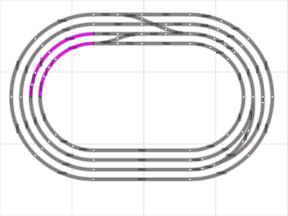
स्टैंडर्ड समानांतर मतदान geometries

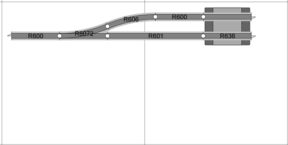
एक्सप्रेस समानांतर geometries मतदान
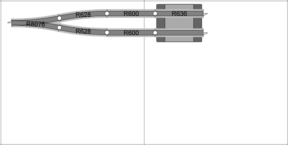
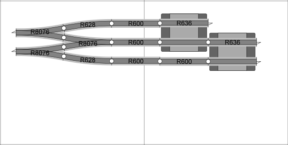



Angled मतदान geometries
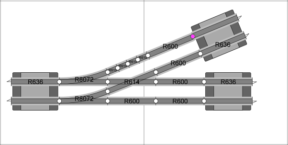


घुमावदार मतदान geometries


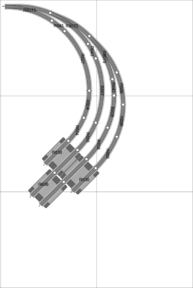


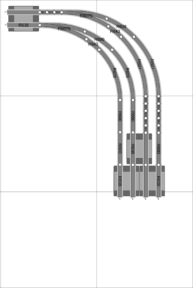
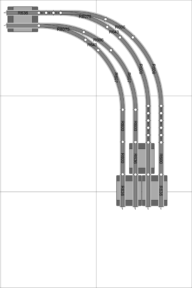
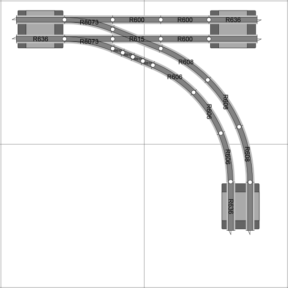
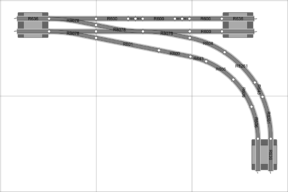
एक्स ge क्रॉसिंग और कैंची-क्रॉसिंग ज्यामितीय
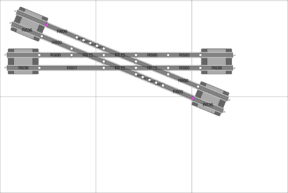


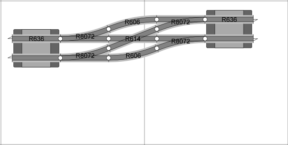



Y omet जंक्शन और T unction जंक्शन ज्यामितीय
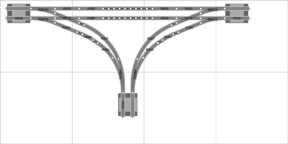
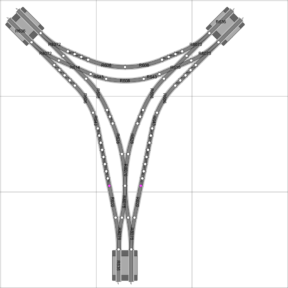
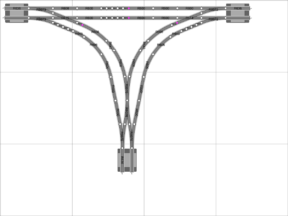
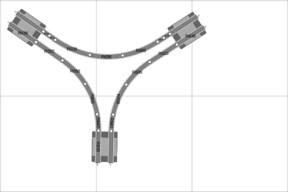
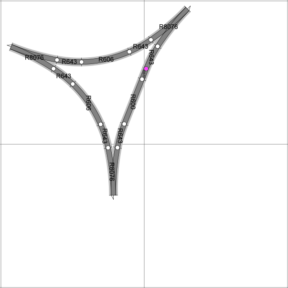
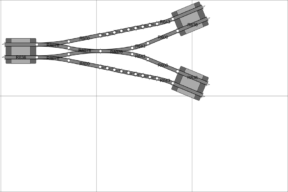
बेसिक स्टेशन geometries






मेजर स्टेशन geometries







घुमावदार स्टेशन geometries
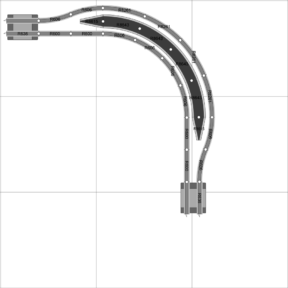
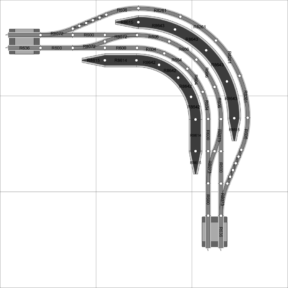
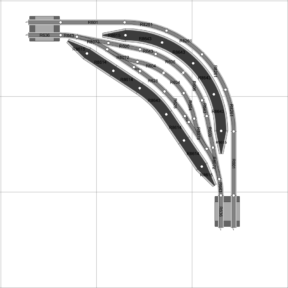
टर्नटेबल geometries के साथ टर्मिनस स्टेशन



turntable geometries

4जंक्शन जंक्शन ज्यामिति
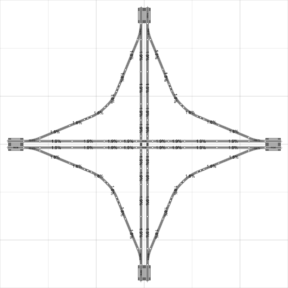
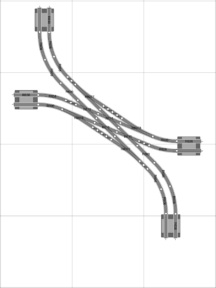
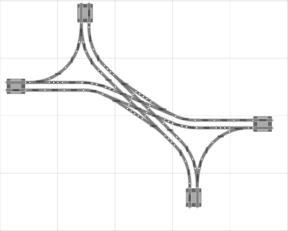
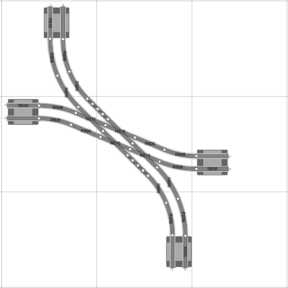

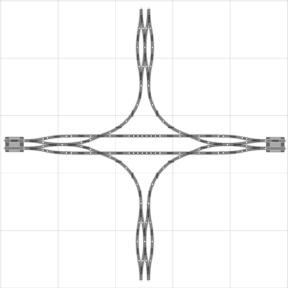
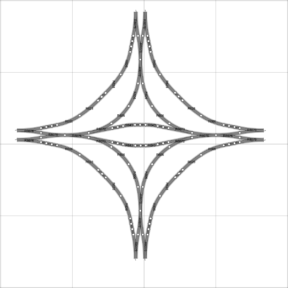
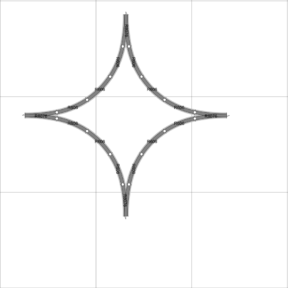
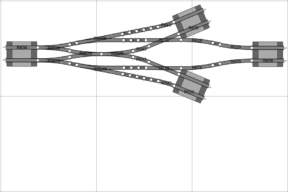
अन्य geometries
अनुरोध के द्वारा geometries

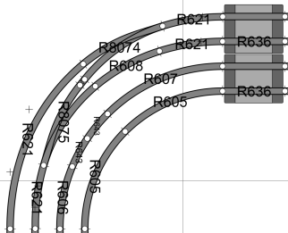


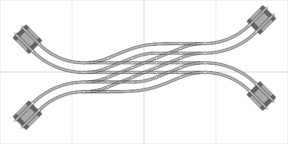
कृपया नीचे दिए गए अन्य लेआउट के लिए कोई भी अनुरोध पोस्ट करें.



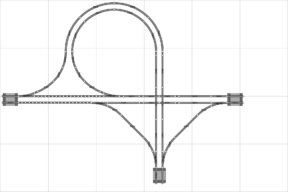
हाय जॉन, fanstastic resource thanks for producing this. I’m struggling with trying to get a R8074 to run into a parallel through station. For example trying to use Ropley on Mid Hants Railway as example. Is it possible? I can get close if i use R8077 and a R600 + R628.
प्रिय जॉन कुछ सलाह देने में सक्षम होंगे. I would like to model Bradford exchange station in the 1930’s particularly around the the St Dunstans junction which is a triangular loop. If I can create the space I would like to include the hammerton junction and the run back down to the Adolphus street goods station
Hi Simon
I recommend looking for old maps of the area, importing them into anyrail as an image, and then layout out track over the top — that is how I created the layouts for the sheffield stations that I have shared. If you need specific advice about anything do ask
नमस्ते, some really good points and graphics here.
My question is.
I want a low level non-scenic return loop. I believe I can use 2nd radius curves. My biggest loco is a B12 4−6−0 with a maximum train length of 3 thompson carriages.
I also want to hold a train there, while a second one passes through. Or hold either one, while the other moves off. I have a length of just under 8ft, as my layout is just under 8ft by just under 10ft.
This will be a low level affair so I can have a double track main level with an upper level branch. Hope you understand my question thanks
Hi Scott
I recommend trying AnyRail or an equivalent track layout tool as you can then experiment yourself with what will work.
हाय जॉन
I have a OO gauge Hornby Flying Scotsman R1167 (कोड 100) set and a HO gauge Life-Like Union Pacific T8608AA (कोड 83?) set.
Is it feasible to join them to use in two loops or will the change in track height create problems?
This idea is more about utilising the track I have than running both OO and HO locomotives together.
Appreciate your suggestions.
मोनिका
Hi Monique
There is a good chance you’ll have problems running the code 100 कोड पर लोको 83 track as older models often have deeper flanges on the wheels. The HO loco will almost certainly run fine on code 100 track if it runs on code 83 track.
I’d highly recommend testing the Flying Scotsman on code 83 track before committing to anything as it may well “ride on the ties” or have issues with turnouts and frogs. If you find it works reliably then there is no reason you can’t mix track for use with both locos. If you have old rolling stock that doesn’t like the code 83 track it is easy to switch the wheels to ones with smaller flanges. I wouldn’t want to try swapping wheels with locos though, it would probably involve a lot of precision DIY.
There are products out there that will allow you to join code 83 to code 100 track without an issue, उदाहरण के लिए:. Atlas rail joiners with product code 551. If you have code 75 track then Peco make a track joiner for code 75 to 100 too.
Assuming everything does work then I would recommend using code 83 on scenic sections and code 100 for fiddle yards as the code 83 will look more realistic.
I attempted to recreate the angled turnout geometry (the smaller of the three) and for some reason it does not appear to fit. the R614 crossover combined with the R8072 switches do not preserve the distance between tracks to match the R636 Level Crossing both on the straight and angled areas. I am using SCARM though and not AnyRail (I assume you used that one) so the two programs may have different dimensions for the individual pieces but I don’t want to invest in the actual pieces or commit to the design only to find out they won’t fit on final assembly.
Hi Tony
The pink dots are where there is an imperfect but very small misfit. This would easily be accounted for by using a piece of flexitrack — it is small enough to not matter I believe
Thank you so much for making these. वे बहुत मददगार हैं.
A tip picked up from Model Rail is the Hornby 2nd त्रिज्या 1⁄4 curves can be used with the Y points to give a longer straight and minimal 50mm between centres.
ALL the Hornby radii can be used to create a diminishing/increasing radius curve which can be useful information when linking scenic and non-scenic sections of a layout.
Hornby Large radius R8077 & R8078) and Y points (R8076) can be used in combination for release roads at terminal stations, with the Y connecting to the diverging of the large radius points.
Any single Hornby 45degree curve R1 — R4 will connect to the diverging branches of short Hornby points (R8072 & R8073) the infinite radius link being formed by a cut length of R621 Flex a useful fix when working in O‑16.5 and other light/tramways were odd point-work arrangements were used to access water tanks or provide loco stabling off of the single mainline.
Similarly and half curve (22.5degrees) will work in similar fashion in combination with large radius points.
Anyrail is useful to set out the basic principles of what section works with which component to construct your needs.
Sectional track gets a bit of an iffy press BUT it can also provide a work round due to it’s constant arc be it 11.25, 22.5 या 45 degrees.
हाय स्टुअर्ट
That’s really good info thanks.
For anyone new to modelling I wouldn’t generally recommend SeTrack anyway, it’s just there is a lot of it out there that is still perfectly usable and for “toy train” layouts as opposed to “models” it’s quicker and easier to get a working layout.
Awesomeness information Sir!!
Could you possibly post the most economic for point space, a 16 road marshalling yard please??
Hi Richard
I’m not sure exactly what you mean. I assume you don’t want to construct a cassette or sliding system — you’re looking for a 16-road fixed yard?
But I’m not sure what you mean by “economic for point space”?
Is this for a scenic area — i.e. a model of a marshalling yard, or is it for an off-scene area?
Assuming it’s for an off-scene area you presumably don’t care about prototypical operation — you just want to maximum ‘storage’ in th eminimum space or with the minimum number of points?
Are you wanting something double ended (अर्थात. with a through-track for a loop) or something ‘dead-end’? How many tracks do you need leading into each end?
Hi ya
Many thanks for coming back to me!
The marshalling yard is a background area.
I’m extremely pushed for space, in that I want to store 8 coach trains which is fine except that the points are taking up to much space that I haven’t got? So basically I need to get my 16 lanes in the shortest way possible with the points overall length
Hope that makes sense?
The less space wasted with the points length the better
Many Thanks again
Richard
Hi Richard
That makes sense. It sounds like you want a ‘staging yard’ specifically
Are you using Horny SeTrack or something else (उदाहरण के लिए:. Peco कारगर)?
How many tracks do you have coming in? Just 1 or more? E.g. if you have 2 could you have 2 separate 8‑lane sections. Or do you need to feed all 16 lanes into 1?
Is it just connected at one end or at both ends — i.e. does it need to have a run through part?
Assuming a single track entry with no pass-through the shortest length I can see so far would have the points take up 1m of length before your straight sections. 8‑coach trains would be about 2.5m long including a single-engine or a bit longer for MUs so you’d be looking at a total length of 3.5m and a width of ~1.6m. I’ve included a design below.
If you are tight for space you might be better with a traverser or elevator. Have a look at https://modelrailwayengineer.com/fiddle-yards/ for different possible approaches
Hi ya Jon
This is perfect for what I want to achieve, मैं आपको पर्याप्त धन्यवाद नहीं दे सकता!!
फिर से धन्यवाद
Kindest Regards
Richard
Hi Richard
After thinking about this some more I came up with an improved design. The length is marginally shorter but the main benefit is that the width is smaller (around 1m rather than around 1.6m) which means the furthest tracks will be much easier to reach. Note that the light blue parts are shown for design purposes but actually form part of the roads themselves, so the pointwork is less than 1m long
If anyone has any thoughts on a more efficient design please let me know
Fantastic information. All the information that you http://www.freetrackplans.com/Track-Plan-Index.php need to calculate the part no. and see what is what brilliant. All you need is to get picked up by google when track geometry is put in
हाय क्रिस. Agreed — FreeTrackPlans.com is great. I’ve generally tried to avoid duplication of the info they provide so I can recommend a good look at the many plans they have
Hi Jon — really great site — thanks. I am new to using AnyRail — and planning first layout.Reference the ‘geometries by request’ section — top line — second from left — could you post the angle and radius of the various R621 sections you are using, please? I am having a problem replicating the diagram on Anyrail. Would be much appreciated.
Hi Iain
There are 4
The one next to the road-crossing on the R4 curve is r=54, a=17.5
The one below it on the R3 curve is r=56.5, a=17.5
The longer one on the R4 curve is a custom adjusted smooth curve with rmin=52.68
The final one — at the bottom of the R3 curve is r=56.5, a=17.5
Hope that helps. If not I can send the .any file over, just let me know
Jon — that’s really helpful — thanks. इयान
Would it be possible to incorporate a R8075 point on a 4वें radius R8262 so as to create a spur off and then to effectively have the inner curve back on alignment (presently a complete 180 degree 4वें radius curve) possibly by having short R410’s prior to the point? बहुत धन्यवाद.
Hi Jeff
I assume you mean on the standard Hornby 4‑track loop or equivalent 180 curve?
यदि हां तो हां, although not without cutting one of the R610’s short. I assume you mean R610’s?
You need to use R610 -> R8075 -> R610 -> R610 (cut short) -> R643. This will have the same start and end points as a 90 degree 4वें radius corner. Note that it does include the 2nd radius R643.
If you wanted to achieve the same thing without the R643 you could use flexitrack to create a piece with a standard 4वें radius of 572mm and a curve of 11.25 degrees. It is a shame Hornby don’t make one of these as standard as it would fit near perfectly in a pattern of R610 -> R8075 -> flexipiece which would form a smoother curve also of 90 degrees and fitting into place of a 4वें त्रिज्या 90 degree turn
बेशक, flexitrack is a good idea anyway as you can then include easements which both look better and improve smooth running
Can you tell me the thickness (underside of sleeper to top of rail) of Peco 00/H0 Streamline Code 100 track? Every millimetre counts as I attempt establish the gradients on a layout that I am planning!
Thankyou.
हाय इयान.
I haven’t measured it precisely myself but I believe sleeper thickness is 2mm. The track on top of that is code 100 — i.e. 0.1inches or 2.54mm in metric. So in total from baseboard to top of track you’re looking at 4.5mm
For more info have a look at https://www.modelrailforum.com/forums/index.php?showtopic=27708
दिलचस्प धन्यवाद, लेकिन ध्यान दें कि Peco Streamline घुमावदार ट्रैक नहीं करती है, इसलिए लचीले ट्रैक के लिए न्यूनतम के अलावा रेडी नहीं हो सकती है, और वो रेडी 50 मिमी अलग नहीं हैं.
अंक के लिए वक्र त्रिज्या 610 मिमी पर ’छोटा’ है / 2 पैर, Mm मध्यम ’914 मिमी पर / 3 1524 मिमी पर पैर और 'बड़े' / 5 पैर.
बिंदु कोणों को जोड़ने का भी सुझाव दें, 22.5हॉर्बी के लिए °, 12पेको एस के लिए °
धन्यवाद विधेयक. मैंने वक्र त्रिज्या पर स्पष्टीकरण जोड़ा है और बिंदु कोणों पर अपना सुझाव भी जोड़ा है.
बहुत उपयोगी जानकारी के लिए धन्यवाद बस फिर से शुरू हो गया है 64 Ive finally got the space and the time. now.
मुझे यह सुनकर अच्छा लगा. This period of being stuck at home at least has the upside that it’s a great time to get back into modelling.
जॉन, क्या यह मान लेना सुरक्षित है कि चित्रण के लिए प्रयुक्त ग्रिड 12 the पर सेट है (305) यदि नहीं, तो आप किस पैमाने पर काम करते हैं?
हाय स्टुअर्ट. पूर्व भौतिकी शिक्षक के रूप में मैंने मीट्रिक प्रणाली को बहुत अधिक अपनाया है (और मेरा मानना है कि AnyRail सॉफ्टवेयर जर्मनी से है) इसलिए माप सभी मीट्रिक हैं. जहां उन्हें ग्रिड लाइनें दिखाई जाती हैं वे 500 मिमी वर्ग को दर्शाती हैं.
उत्कृष्ट संसाधन! यहां तक कि फ़्लॉक्सट्रैक का उपयोग करने के लिए आपको उपयुक्त आयाम और लोड का पता होना चाहिए अन्यथा ट्रैक के बेकार जंग खाए पुराने बिट्स को नए ट्रैक का अनुसरण करने के लिए आकार देने के लिए टेम्पलेट के रूप में उपयोग किया जा सकता है. धन्यवाद.
कॉन्फ़िगरेशन के त्वरित संदर्भ के लिए पवित्र ग्रिल. Very much appreciate the amount of work put in and thank you for sharing.
महान साइट अत्यंत बुनियादी डिजाइन की जानकारी देने में सहायक, आपके प्रयासों के लिए धन्यवाद. मेरा एक सवाल है?
मैं कल्पना करने के लिए अगर यह पक्ष के साथ शामिल हो गए द्वारा ट्रैक पक्ष के दो हलकों होना संभव नहीं है कोशिश कर रहा हूँ 4 घुमावदार अंक इतना हलकों अलग से चलाया जा सकता है या बंद कर अंक के साथ का एक आंकड़ा बनाने के लिए 8. अंकों के साथ एक एक्स को पार करने की जगह दूसरे शब्दों में. Thanks for any guidance.
यह एकल ट्रैक लूप के साथ निश्चित रूप से संभव है. एक डबल ट्रैक लूप अधिक जटिल होगा. मैंने एकल ट्रैक आकृति ’8 की एक छवि जोड़ी है / double loop layout
इन के लिए धन्यवाद. I would suggest moving the curved crossover to its own diagram.
वहाँ एक ज्यामिति है कि एक के लिए अनुमति देता है 2nd एक में त्रिज्या वक्र 3तृतीय या 4वें त्रिज्या सर्कल? कुछ एक पर वक्र के साथ अंक अनुमति देने के लिए 3तृतीय त्रिज्या सर्कल.
मुझे यकीन है कि जो "घुमावदार विदेशी" आप की बात कर रहे नहीं कर रहा हूँ.
मैं भी काफी कुछ नहीं आप एक से क्या मतलब कर रहा हूँ 2nd एक में त्रिज्या वक्र 3तृतीय या 4वें त्रिज्या सर्कल? तो यहाँ कई संभावित जवाब कर रहे हैं
(1) मानक हार्नबी चक्र चलता एक 2nd करने के लिए त्रिज्या 3तृतीय radius curved turnout geometry.
(2) मैं एक ऐसा करने के लिए किसी भी तरह से के बारे में पता नहीं कर रहा हूँ 3तृतीय तक 4वें flexitrack का उपयोग किए बिना एक वक्र पर दायरा. flexitrack यह किया जा सकता है के साथ.
(3) यदि आप मतलब है कि यह संभव है उपयोग करने के लिए 2nd त्रिज्या घटता एक में एक आवक मोड़ फिट करने के लिए अंतरिक्ष सक्षम करने के लिए 3तृतीय या 4वें त्रिज्या तो बारी हाँ यह है - तुम सिर्फ यह करने के लिए मानक हार्नबी पाश को संशोधित कर सकता है, या यह एक अधिक कॉम्पैक्ट तरह से यह करने के लिए संभव है.
मैंने जोड़ लिया है 2 अतिरिक्त ज्यामिति कैसे करना है दिखाने के लिए (2) flexitrack साथ और (3) के साथ 3तृतीय त्रिज्या, हालांकि यह एक बिल्कुल सही फिट नहीं है, यह पास पर्याप्त असली दुनिया हो जाएगा.
हम बड़े पैमाने पर दान किए गए घटकों से स्थानीय बच्चों के दान के लिए धन जुटाने के लिए एक बच्चे के अनुकूल लेआउट का निर्माण कर रहे हैं, तो आपकी जानकारी के लेआउट डिजाइनिंग setrack घटता प्रयोग करने के लिए विशेष रूप से उपयोगी था.
एक दम बढ़िया. आपकी प्रतिक्रिया का धन्यवाद. हम हमेशा कुछ भी धर्मार्थ के लिए 'विज्ञापन' का स्वागत करते हैं, इसलिए हमें पता है कि यह के बारे में अधिक जाने के लिए स्वतंत्र महसूस.
चियर्स
जॉन, अपने काम के लिए धन्यवाद, शर्म की बात है मैं सिर्फ अपने ट्रैक डालने के शुरू करने के बाद पता चला. तुम्हारा काम, मगर, has been useful in correcting my track laying mistakes.
धन्यवाद जॉन, This has been really helpful… I’m now going to sit down and digest much of this and then try in AnyRail to create my own solutions based on the ones you’ve provided here! 🙂
क्या आकार भरा हुआ है 4 ट्रैक लेआउट का उपयोग कृपया 4वें radius?
की त्रिज्या 4वें त्रिज्या 572mm है - तो कुल व्यास 1144mm हो जाएगा (1.15मीटर या 45 इंच). यही कारण है कि ट्रैक के केंद्र के लिए है, ताकि आप शारीरिक आवश्यक स्थान के लिए एक छोटी राशि पर जोड़ने की जरूरत होगी. मैं दोनों ओर से आधे से एक ट्रैक चौड़ाई पर जोड़ने का सुझाव चाहते हैं, और दोनों ओर से आधे से एक ट्रैक रिक्ति. यही कारण है कि अंतरिक्ष के 1228mm के महायोग की जरूरत देता है (1.23मीटर या 48 1⁄3 इंच). मैं उसके ऊपर अपने आप पर त्रुटि के लिए एक छोटे से मार्जिन चाहते हैं.
नमस्ते,
इस पर एक नौसिखिया आप बोर्ड मैं की appx समग्र आकार की पुष्टि कर सकते होने के नाते।, ई. 1.3मीटर x 1.3M हार्नबी मानक etc.for 4 पाश ट्रैक.
बहुत बहुत धन्यवाद.
बॉब
ग्रिड वर्गों 50cm एक्स तो मानक 50 सेमी हैं 4 ट्रैक पाश लगभग 1.4M एक्स 2 एम है.
उचित ट्रैक निकासी के साथ के रूप में एक बोर्ड 1.25m एक्स 1.9M पर दिखाए यह लगाया जा सकता है - और अधिक सटीक मैं AnyRail में यह मापा गया तो वे.
सुपर आइटम, जॉन. क्षमा करें यदि मैं इसे यहाँ नहीं छूटा है, लेकिन जब आप ट्रैक रिक्ति का उल्लेख, 50 मिमी के रूप में उदाहरण के H0, कैसे है कि अंतरिक्ष में मापा जाता है? यह दो पटरियों के स्लीपरों या कहते हैं कि के किनारों के बीच की जगह है, ट्रैक के केंद्र से केंद्र को ट्रैक करने के?
केंद्र के लिए ट्रैक केंद्र.
इसे करने के लिए आपका धन्यवाद, यह मदद मिली है मुझे एहसास क्या हासिल किया जा सकता.